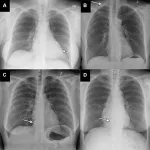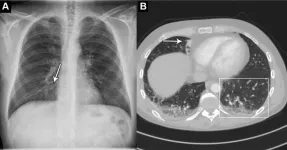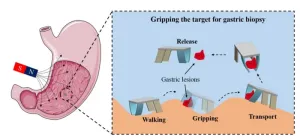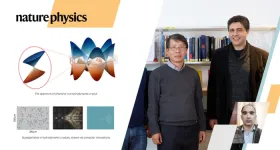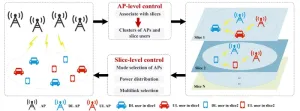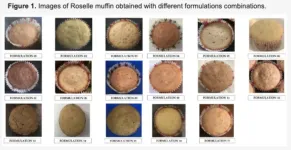(Press-News.org)
Macrophages are highly specialized cells of the immune system that help the body detect and fight deadly pathogens. In particular, M1-like macrophages detect and destroy tumor cells, and release protective chemokines such as interleukin (IL)-6 and tumor-necrosis factor α (TNF α), thus shielding the body from life-threatening pathologies like cancer. However, not all macrophages show anti-tumor potential. Certain types of macrophages, i.e., M2-like macrophages, promote tumor growth. Luckily, the desired macrophage phenotype—a set of traits resulting from the genetic makeup of the macrophage—can be activated by modulating the physiological microenvironment of the cells. Interestingly, multiple nanomaterial-based immunomodulators have been developed in the past, which are known to facilitate the phenotype transition of macrophages from M0 to M1.
Recently, a team of researchers led by Dr. Na Kong and Dr. Yuan Yao from the ShanghaiTech University, China, conducted a study to design novel immunomodulators—biomimetic polypeptides (BMPPs)—that could activate tumor-infiltrating macrophages, i.e., M1-like macrophages. Their study was published on 4 January 2023 in volume 5 of BioDesign Research.
Elaborating on the development of BMPPs, Dr. Yao remarks, “Combining de novo protein design and biosynthesis techniques, we designed a BMPP self-assembled nano-immunomodulator to trigger the activation of a specific macrophage phenotype. It was intended to be made up of (GGSGGPGGGPASAAANSASRATSNSP)n, the RGD motif from collagen, and the IKVAV motif from laminin.”
It is important to note, that previously developed nano-immunomodulators exhibited clear limitations, such as biotoxicity and low biocompatibility.
To overcome such limitations, Dr. Yao and team tried a unique approach. They designed and biosynthesized a biomimetic nanofibril—a highly ordered and stable structure comprising self-assembled repetitive building blocks. To do so, they validated the predicted monomers and higher-order complexes using molecular dynamics simulations—computational studies used to mimic the movement of atoms, molecules, or even large biomolecules such as polypeptides and proteins. The resultant BMPPs specifically harbored the RGD and IKVAV motifs—small nature-conserved regions from proteins—because prior studies have shown that these motifs contain amino acid residues with putative immunomodulatory capabilities.
Following biosynthesis, the team conducted a variety of assays including enzyme-linked immunosorbent assay (ELISA), to test the efficacy of the newly biosynthesized BMPPs. Cell proliferation assays conducted using RAW264.7 cells demonstrated the general biosafety and cytocompatibility of BMPPs. Moreover, results from ELISA revealed that BMPP nano-immunomodulators increased the protein expression levels of IL-6 and TNFα, without affecting the expression levels of IL-10. This clearly demonstrated that M1 macrophage polarization occurred at high BMPP concentrations and that BMPP nano-immunomodulators were presumably activating the M1-like macrophages.
How have these findings contributed to the long-term goals of the research team? “Unlike metal or synthetic polymer-based nanoparticles, these BMPPs exhibit excellent biocompatibility, high efficacy, and precise tunability in immunomodulatory effectiveness. With such encouraging findings, we are motivated to continue our research into cancer immunotherapy applications,” muses a hopeful Dr. Yao.
Reprogramming the tumor microenvironment by activating M1-like macrophages is an excellent way to boost tumor immunotherapy. Kudos to the research team for drawing inspiration from nature and for adding a potent weapon to our cancer-fighting arsenal.
###
Reference
Authors
Na Kong1, Hongru Ma2,3, Zhongji Pu2,3, Fengju Wan1, Dongfang Li2, Lei Huang2,3, Jiazhang Lian2,3, Xingxu Huang4,5, Shengjie Ling1,6, Haoran Yu2,3, and Yuan Yao1,2,3
Affiliations
1School of Physical Science and Technology, ShanghaiTech University,393 Middle Huaxia Road, Shanghai 201210, China.
2ZJU-Hangzhou Global Scientific and Technological Innovation Center, Zhejiang University, Hangzhou 311215, China.
3College of Chemical and Biological Engineering, Zhejiang University, Hangzhou, Zhejiang 310027, China.
4Zhejiang Lab, Hangzhou, Zhejiang 311121, China.
5School of Life Science and Technology, ShanghaiTech University, Shanghai 201210, China.
6Shanghai Clinical Research and Trial Center, Shanghai 201210, China.
END
OAK BROOK, Ill. – An artificial intelligence (AI) tool can accurately identify normal and abnormal chest X-rays in a clinical setting, according to a study published in Radiology, a journal of the Radiological Society of North America (RSNA).
Chest X-rays are used to diagnose a wide variety of conditions to do with the heart and lungs. An abnormal chest X-ray can be an indication of a range of conditions, including cancer and chronic lung diseases.
An AI tool that can accurately differentiate between normal and abnormal chest X-rays would greatly alleviate the heavy workload experienced by radiologists globally.
“There is an exponentially growing demand for medical ...
A study at Hospital for Special Surgery (HSS) found that intraoperative three-dimensional (3D) imaging was superior to two-dimensional radiographs in confirming the accuracy of pedicle screw placement during spine surgery. The research was presented today at the American Academy of Orthopaedic Surgeons (AAOS) Annual Meeting in Las Vegas.
Many spinal surgeries require the use of implants called pedicle screws to stabilize the spine. Precise positioning of these screws is critical for a successful outcome. “Two-dimensional biplanar radiographs [BPR] ...
Recently, a research team from Shenzhen Institute of Advanced Technology, Chinese Academy of Sciences, proposed a bionic quadruped soft thin-film microrobot actuated by magnetic fields with a mass of only 41 mg, which promises to be applied to stomach examination and treatment. Researchers realized the multimodal locomotion control of the soft microrobot in magnetic fields and the grasping and transportation of micro-objects by the soft microrobot.
The new paper, published in Cyborg and Bionic System, details the process ...
Starting with the emergence of quantum mechanics, the world of physics has been divided between classical and quantum physics. Classical physics deals with the motions of objects we typically see every day in the macroscopic world, while quantum physics explains the exotic behaviors of elementary particles in the microscopic world.
Many solids or liquids are composed of particles interacting with one another at close distances, which sometimes results in the rise of “quasiparticles.” Quasiparticles are long-lived excitations that behave effectively as weakly interacting particles. The idea of quasiparticles was introduced by the Soviet physicist Lev Landau in 1941, and ...
Network-assisted full-duplex (NAFD) systems enable uplink and downlink communications within the same time-frequency resources, so as to avoid the overhead of switching uplink/downlink modes. However, as the number of users and access points (APs) proliferated, mass access brings significant overhead in mode selection. In addition, the differentiated service demands among users also makes the effective utilization of resources difficult. Combined with network slicing technology, a slicing capacity-centered mode selection and resource optimization scheme is proposed. This scheme adopts a double-layer deep reinforcement ...
“As a Black woman, I’m invisible. They just erase your humanity. You don’t exist in front of them.” (Tessa, 33-year-old Black research assistant)
“It wasn’t about disliking what I did or being judgmental of what I did. It was a different kind of problem, to not be acknowledged. They didn’t care. There was no curiosity. They didn’t give a f***. We were invisible.” (Brinda, 30-year-old South Asian consultant)
Invisibility is a salient and recurring experience of mistreatment for women of colour working in traditionally white and male professions, two ...
Love muffins? We’re talking about a tasty, fluffy muffin that has no artificial additives and that simultaneously contains lots of beneficial nutrients. As remarkable as it might sound, a recently published study led describes the development of just such a new muffin in the journal Foods.
From muffins to functional food
The new super muffin has been named Roselle, because it contains calyx extract from the tropical plant Hibiscus sabdariffa, which is often referred to by the same name.
[caption id="attachment_79738" align="aligncenter" width="559"] Here's a look at the different formulations that researchers tested. Photo: Screenshot from Food ...
Will AI drive the next biomedical revolution? Why is RNA so powerful? What can we learn from studying bias? You’ll get the answers to these questions and more at Discover BMB, the annual meeting of the American Society for Biochemistry and Molecular Biology, to be held March 25–28 in Seattle.
Reporters are invited to register for a complimentary press pass to attend #DiscoverBMB in Seattle or to access press materials electronically.
This year’s #DiscoverBMB program features leading ...
Color plays a huge role in our lives — the hues we wear and decorate with are a way for us to signal who we are, where we’re from, and what we care about. And it’s been that way for a long time. In a new study in the Journal of Archaeological Science: Reports, archaeologists compared the colors on pieces of ancient Peruvian pottery. They found that potters across the Wari empire all used the same rich black pigment to make ceramics used in rituals: a sign of the empire’s influence.
The Wari empire spread over Peru’s highlands and coastal areas from 600-1050 ...
According to NOAA Fisheries, more than 80 percent of marine aquaculture production in the United States consists of bivalve mollusks such as oysters, clams and mussels. However, it’s not just humans who enjoy eating these shellfish, so do marine rays. They like to “crunch” on clams, which can sometimes take a big bite out of clammers’ profits.
Part of the process of culturing hard clams (Mercenaria mercenaria) involves deploying them in submerged bottom leases in the marine environment where clams can grow to market size. When deployed onto the clam lease, clammers incorporate a variety of anti-predator ...

